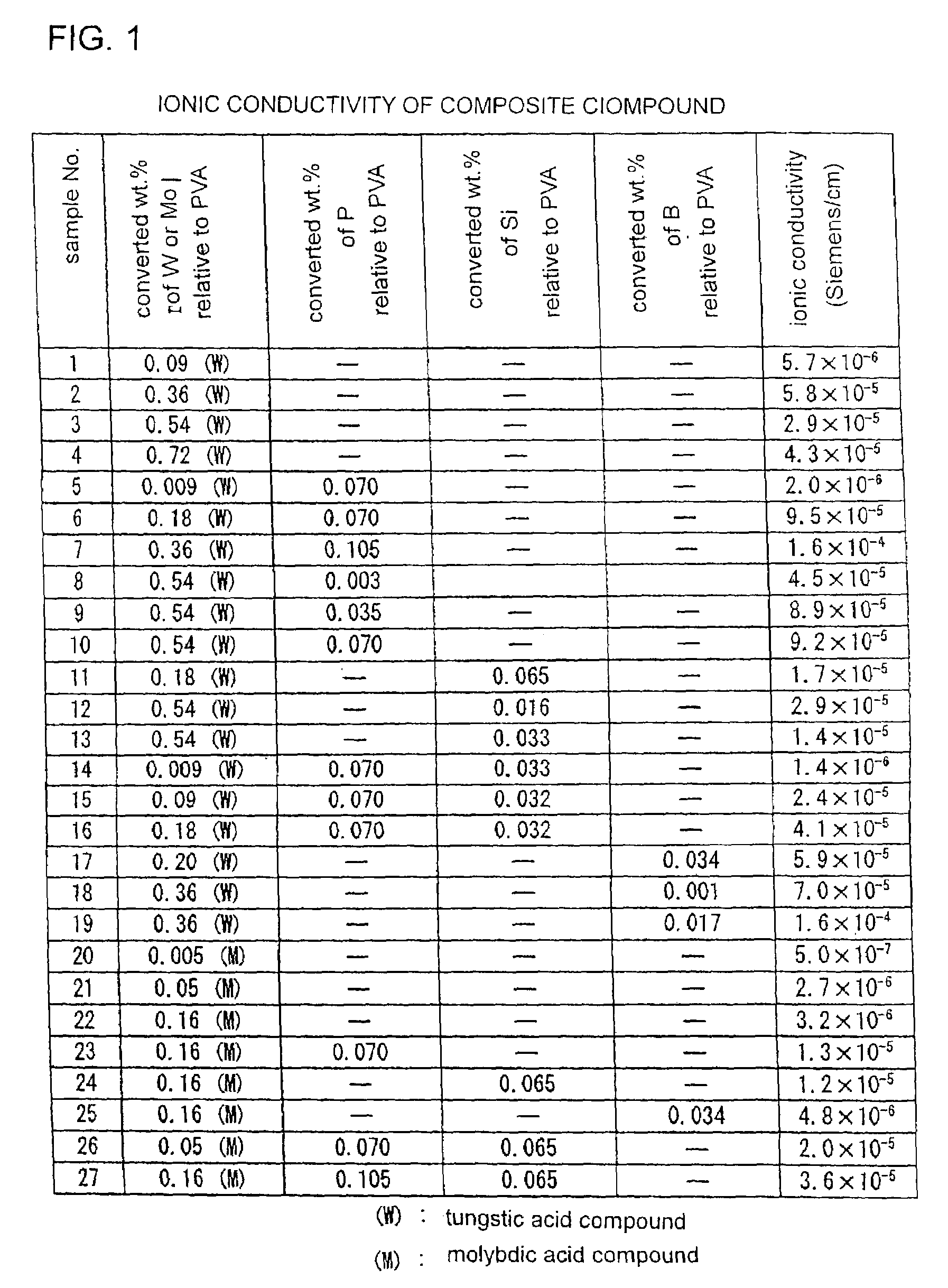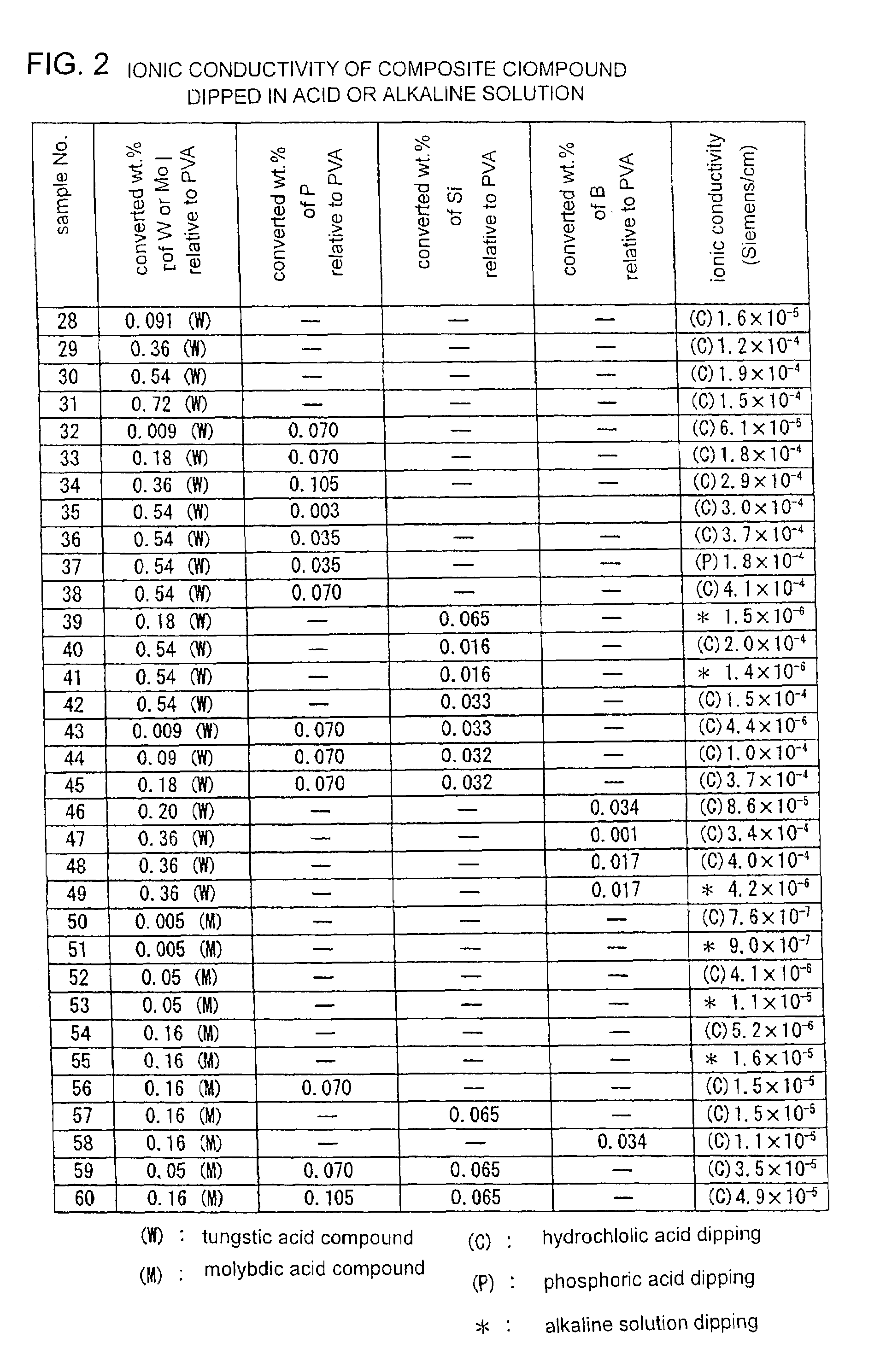Ionic conductive solid electrolyte, method of manufacturing the same and electrochemical system using the same
a solid electrolyte and ionic conductive technology, applied in the direction of non-aqueous electrolyte cells, non-metal conductors, electrochemical generators, etc., can solve the problems of low cost of products, complicated manufacturing process of perfluorosulfonic acid electrolyte, and limited cost merit, so as to achieve high ionic conductive, easy to manufacture, and low cost
- Summary
- Abstract
- Description
- Claims
- Application Information
AI Technical Summary
Benefits of technology
Problems solved by technology
Method used
Image
Examples
embodiment 1
[0037]Electrolyte films were obtained by a neutralization reaction in a raw material aqueous solution of prescribed quantity of sodium tungstate and / or sodium molybdate dissolved in 80 cc aqueous solution of 2 wt. % mixture of 50 wt. % polyvinylalcohol (PVA) of which average molecular weight was 120,000 to 190,000 and saponification degree was 87 to 89% and 50 wt. % PVA of which average molecular weight was 18,000 to 26,000 and saponification degree was 100%. The raw material aqueous solution was stirred and was neutralized by dropping 1.2 M concentration hydrochrolic acid until the pH of the raw material aqueous solution becomes “1”. Then, the raw material aqueous solution was poured into two schales of 90 mm in diameter and was dried at 50° C., thereby removing water as a solvent. Films left on the schales after drying were peeled off and were heated at 100° C. for 3 hours in the air in an oven. Then, the films were washed in 70 to 80° C. hot water.
[0038]The samples No. 1 to No. 4...
embodiment 2
[0046]The electrolyte films of the Embodiment 1 as shown in FIG. 1 were further dipped either in acid solution in order to promote protonation, or in alkaline solution in order to promote alkalization. The results of the protonation and alkalization are shown in FIG. 2. During the acid dipping, the electrolyte films were dipped for 3 hours in 1.2 M concentration hydrochloric acid or 8.5 wt. % concentration phosphoric acid and then the films were washed sufficiently. On the other hand, during the alkali dipping, the electrolyte films were dipped for 3 hours in 0.02 M concentration sodium hydroxide and then, the films were dried without washing and their surfaces were wiped.
[0047]In FIG. 2, the hydrochloric acid dipping is denote by(C), the phosphoric acid dipping is denoted by (P) and the alkai dipping is denoted by (*).
[0048]The ionic conductivities of tungsten containing samples dipped in the acid solution such as No. 28 to 49 are remarkably raised up by the acid dipping. Particula...
embodiment 3
[0051]An effect of heating condition on the samples as shown in FIG. 1 is explained. Although the sample films were heated at 100° C. for 3 hours in the air in the oven in the Embodiment 1, the same composition sample as the sample No. 9 (only phosphoric acid compound was added) was manufactured in accordance with the manufacturing method as explained in the Embodiment 1, except that the heat condition was changed from 100° C. for 3 hours to 80° C. for 6 hours. However, the film was remarkably weakened by washing in the hot water and could not maintain its film shape. On the other hand, the same composition sample as the sample No. 15 (phosphoric acid compound and silicic acid compound were added) was manufactured in accordance with the manufacturing method as explained in the Embodiment 1, except that the heat condition was changed from 100° C. for 3 hours to 50° C. for 10 hours. The film was strong enough to be washed and to maintain its film shape. Therefore, it can be considered...
PUM
| Property | Measurement | Unit |
|---|---|---|
| temperature | aaaaa | aaaaa |
| diameter | aaaaa | aaaaa |
| diameter | aaaaa | aaaaa |
Abstract
Description
Claims
Application Information
 Login to View More
Login to View More - R&D
- Intellectual Property
- Life Sciences
- Materials
- Tech Scout
- Unparalleled Data Quality
- Higher Quality Content
- 60% Fewer Hallucinations
Browse by: Latest US Patents, China's latest patents, Technical Efficacy Thesaurus, Application Domain, Technology Topic, Popular Technical Reports.
© 2025 PatSnap. All rights reserved.Legal|Privacy policy|Modern Slavery Act Transparency Statement|Sitemap|About US| Contact US: help@patsnap.com


